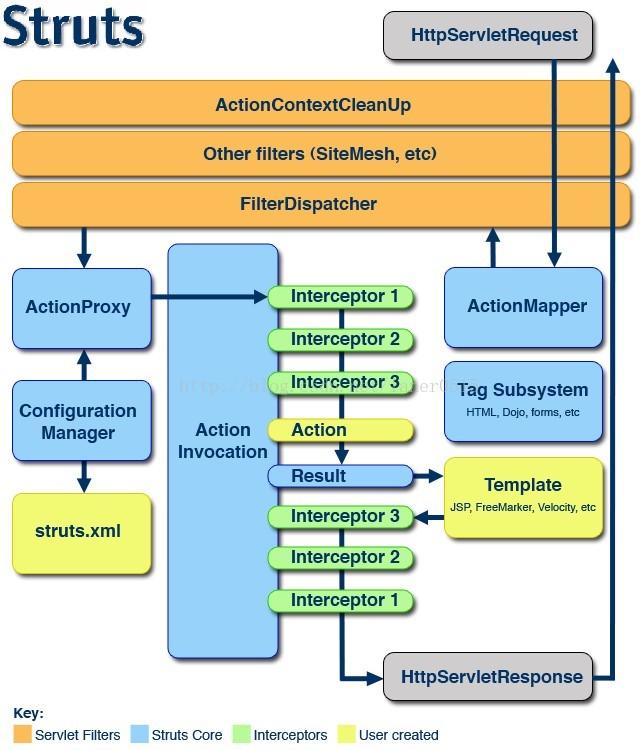Struts2 的核心和工作原理
在学习 struts2 之前,首先我们要明白使用 struts2 的目的是什么?它能给我们带来什么样的好处?
设计目标
Struts 设计的第一目标就是使 MVC 模式应用于 web 程序设计。在这儿 MVC 模式的好处就不在提了。
技术优势 Struts2 有两方面的技术优势,一是所有的 Struts2 应用程序都是基于 client/server HTTP交换协议,The Java Servlet API 揭示了 Java Servlet 只是 Java API 的一个很小子集,这样我们可以在业务逻辑部分使用功能强大的 Java 语言进行程序设计。
二是提供了对 MVC 的一个清晰的实现,这一实现包含了很多参与对所以请求进行处理的关键组件,如:拦截器、OGNL 表达式语言、堆栈。
因为 struts2 有这样目标,并且有这样的优势,所以,这是我们学习 struts2 的理由,下面,我们在深入剖析一下 struts 的工作原理。
工作原理 Suruts2 的工作原理可以用下面这张图来描述,下面我们分步骤介绍一下每一步的核心内容

一个请求在 Struts2 框架中的处理大概分为以下几个步骤
1、客户端初始化一个指向 Servlet 容器(例如 Tomcat)的请求
2、这个请求经过一系列的过滤器(Filter)(这些过滤器中有一个叫做 ActionContextCleanUp的可选过滤器,这个过滤器对于 Struts2 和其他框架的集成很有帮助,例如:SiteMesh Plugin)
3、接着 FilterDispatcher 被调用,FilterDispatcher 询问 ActionMapper 来决定这个请是否需要调用某个 Action,FilterDispatcher 是控制器的核心,就是 mvc 中 c 控制层的核心。下面粗略的分析下我理解的 FilterDispatcher 工作流程和原理:FilterDispatcher 进行初始化并启用核心 doFilter
public void doFilter(ServletRequest req, ServletResponse res, FilterChain chain) throws IOException, ServletException ...{
HttpServletRequest request = (HttpServletRequest) req;
HttpServletResponse response = (HttpServletResponse) res;
ServletContext servletContext = filterConfig.getServletContext();
// 在这里处理了HttpServletRequest和HttpServletResponse。
DispatcherUtils du = DispatcherUtils.getInstance();
du.prepare(request, response);//正如这个方法名字一样进行locale、encoding以及特殊request parameters设置
try ...{
request = du.wrapRequest(request, servletContext);//对request进行包装
} catch (IOException e) ...{
String message = "Could not wrap servlet request with MultipartRequestWrapper!";
LOG.error(message, e);
throw new ServletException(message, e);
}
ActionMapperIF mapper = ActionMapperFactory.getMapper();//得到action的mapper
ActionMapping mapping = mapper.getMapping(request);// 得到action 的 mapping
if (mapping == null) ...{
// there is no action in this request, should we look for a static resource?
String resourcePath = RequestUtils.getServletPath(request);
if ("".equals(resourcePath) && null != request.getPathInfo()) ...{
resourcePath = request.getPathInfo();
}
if ("true".equals(Configuration.get(WebWorkConstants.WEBWORK_SERVE_STATIC_CONTENT))
&& resourcePath.startsWith("/webwork")) ...{
String name = resourcePath.substring("/webwork".length());
findStaticResource(name, response);
} else ...{
// this is a normal request, let it pass through
chain.doFilter(request, response);
}
// WW did its job here
return;
}
Object o = null;
try ...{
//setupContainer(request);
o = beforeActionInvocation(request, servletContext);
//整个框架最最核心的方法,下面分析
du.serviceAction(request, response, servletContext, mapping);
} finally ...{
afterActionInvocation(request, servletContext, o);
ActionContext.setContext(null);
}
}
du.serviceAction(request, response, servletContext, mapping);
//这个方法询问ActionMapper是否需要调用某个Action来处理这个(request)请求,如果ActionMapper决定需要调用某个Action,FilterDispatcher把请求的处理交给ActionProxy
public void serviceAction(HttpServletRequest request, HttpServletResponse response, String namespace, String actionName, Map requestMap, Map parameterMap, Map sessionMap, Map applicationMap) ...{
HashMap extraContext = createContextMap(requestMap, parameterMap, sessionMap, applicationMap, request, response, getServletConfig()); //实例化Map请求 ,询问ActionMapper是否需要调用某个Action来处理这个(request)请求
extraContext.put(SERVLET_DISPATCHER, this);
OgnlValueStack stack = (OgnlValueStack) request.getAttribute(ServletActionContext.WEBWORK_VALUESTACK_KEY);
if (stack != null) ...{
extraContext.put(ActionContext.VALUE_STACK,new OgnlValueStack(stack));
}
try ...{
ActionProxy proxy = ActionProxyFactory.getFactory().createActionProxy(namespace, actionName, extraContext);
//这里actionName是通过两道getActionName解析出来的, FilterDispatcher把请求的处理交给ActionProxy,下面是ServletDispatcher的 TODO:
request.setAttribute(ServletActionContext.WEBWORK_VALUESTACK_KEY, proxy.getInvocation().getStack());
proxy.execute();
//通过代理模式执行ActionProxy
if (stack != null)...{
request.setAttribute(ServletActionContext.WEBWORK_VALUESTACK_KEY,stack);
}
} catch (ConfigurationException e) ...{
log.error("Could not find action", e);
sendError(request, response, HttpServletResponse.SC_NOT_FOUND, e);
} catch (Exception e) ...{
log.error("Could not execute action", e);
sendError(request, response, HttpServletResponse.SC_INTERNAL_SERVER_ERROR, e);
}
} 4、如果 ActionMapper 决定需要调用某个 Action,FilterDispatcher 把请求的处理交给 ActionProxy
5、ActionProxy 通过 ConfigurationManager 询问框架的配置文件,找到需要调用的 Action 类 ,这里,我们一般是从 struts.xml 配置中读取。
6、ActionProxy 创建一个 ActionInvocation 的实例。
7、ActionInvocation 实例使用命名模式来调用,在调用 Action 的过程前后,涉及到相关拦截器(Intercepter)的调用。
下面我们来看看 ActionInvocation 是如何工作的:
ActionInvocation 是 Xworks 中 Action 调度的核心。而对 Interceptor 的调度,也正是由 ActionInvocation 负责。ActionInvocation 是一个接口,而 DefaultActionInvocation 则是 Webwork 对 ActionInvocation 的默认实现。
Interceptor 的调度流程大致如下:
-
ActionInvocation 初始化时,根据配置,加载 Action 相关的所有 Interceptor。
- 通过 ActionInvocation.invoke 方法调用 Action 实现时,执行 Interceptor。
Interceptor 将很多功能从我们的 Action 中独立出来,大量减少了我们 Action 的代码,独立出来的行为具有很好的重用性。XWork、WebWork 的许多功能都是有 Interceptor 实现,可以在配置文件中组装 Action 用到的 Interceptor,它会按照你指定的顺序,在 Action 执行前后运行。
这里,我们简单的介绍一下 Interceptor
在 struts2 中自带了很多拦截器,在 struts2-core-2.1.6.jar 这个包下的 struts-default.xml 中我们可以发现:
<interceptors>
<interceptor name="alias"class="com.opensymphony.xwork2.interceptor.AliasInterceptor"/>
<interceptor name="autowiring"class="com.opensymphony.xwork2.spring.interceptor.ActionAutowiringInterceptor"/>
<interceptor name="chain"class="com.opensymphony.xwork2.interceptor.ChainingInterceptor"/>
<interceptor name="conversionError"class="org.apache.struts2.interceptor.StrutsConversionErrorInterceptor"/>
<interceptor name="clearSession"class="org.apache.struts2.interceptor.ClearSessionInterceptor"/>
<interceptor name="createSession"class="org.apache.struts2.interceptor.CreateSessionInterceptor"/>
<interceptor name="debugging"class="org.apache.struts2.interceptor.debugging.DebuggingInterceptor"/>
<interceptor name="externalRef"class="com.opensymphony.xwork2.interceptor.ExternalReferencesInterceptor"/>
<interceptor name="execAndWait"class="org.apache.struts2.interceptor.ExecuteAndWaitInterceptor"/>
<interceptor name="exception"class="com.opensymphony.xwork2.interceptor.ExceptionMappingInterceptor"/>
<interceptor name="fileUpload"class="org.apache.struts2.interceptor.FileUploadInterceptor"/>
<interceptor name="i18n"class="com.opensymphony.xwork2.interceptor.I18nInterceptor"/>
<interceptor name="logger"class="com.opensymphony.xwork2.interceptor.LoggingInterceptor"/>
<interceptor name="modelDriven"class="com.opensymphony.xwork2.interceptor.ModelDrivenInterceptor"/>
<interceptor name="scopedModelDriven"class="com.opensymphony.xwork2.interceptor.ScopedModelDrivenInterceptor"/>
<interceptor name="params"class="com.opensymphony.xwork2.interceptor.ParametersInterceptor"/>
<interceptor name="actionMappingParams"class="org.apache.struts2.interceptor.ActionMappingParametersInteceptor"/>
<interceptor name="prepare"class="com.opensymphony.xwork2.interceptor.PrepareInterceptor"/>
<interceptor name="staticParams"class="com.opensymphony.xwork2.interceptor.StaticParametersInterceptor"/>
<interceptor name="scope"class="org.apache.struts2.interceptor.ScopeInterceptor"/>
<interceptor name="servletConfig"class="org.apache.struts2.interceptor.ServletConfigInterceptor"/>
<interceptor name="sessionAutowiring"class="org.apache.struts2.spring.interceptor.SessionContextAutowiringInterceptor"/>
<interceptor name="timer"class="com.opensymphony.xwork2.interceptor.TimerInterceptor"/>
<interceptor name="token"class="org.apache.struts2.interceptor.TokenInterceptor"/>
<interceptor name="tokenSession"class="org.apache.struts2.interceptor.TokenSessionStoreInterceptor"/>
<interceptor name="validation"class="org.apache.struts2.interceptor.validation.AnnotationValidationInterceptor"/>
<interceptor name="workflow"class="com.opensymphony.xwork2.interceptor.DefaultWorkflowInterceptor"/>
<interceptor name="store"class="org.apache.struts2.interceptor.MessageStoreInterceptor"/>
<interceptor name="checkbox"class="org.apache.struts2.interceptor.CheckboxInterceptor"/>
<interceptor name="profiling"class="org.apache.struts2.interceptor.ProfilingActivationInterceptor"/>
<interceptor name="roles"class="org.apache.struts2.interceptor.RolesInterceptor"/>
<interceptor name="jsonValidation"class="org.apache.struts2.interceptor.validation.JSONValidationInterceptor"/>
<interceptorname="annotationWorkflow"class="com.opensymphony.xwork2.interceptor.annotations.AnnotationWorkflowInterceptor"/>对于 sturts2 自带的拦截器,使用起来就相对比较方便了,我们只需要在 struts.xml 的 action 标签中加入
如果是要自定义拦截器,首先需要写一个拦截器的类:
